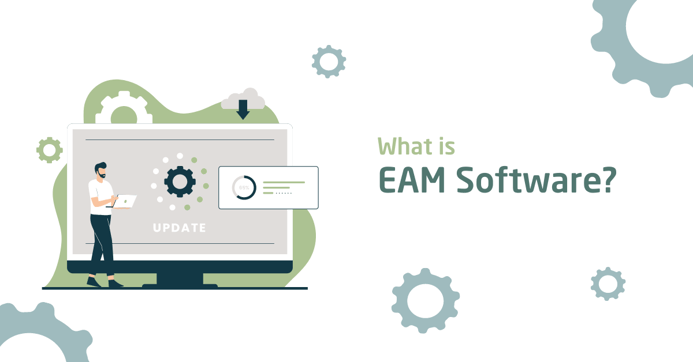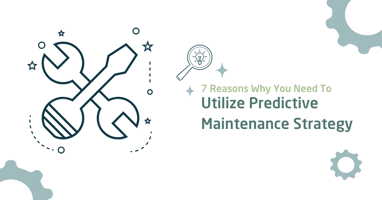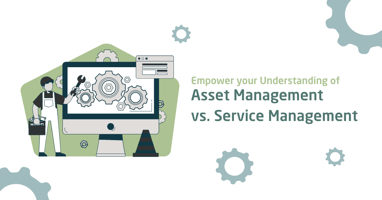
Enterprise Asset Management (EAM) software streamlines asset management across an entire organization, benefiting diverse functions. It offers a comprehensive view of assets from design to disposal, optimizing productivity, reducing costs, and enabling effective asset lifecycle management. EAM integrates with ERP systems, enhancing data consistency and decision-making.
EAM software is essential for asset-intensive organizations, providing them with centralized information, mobile access, and real-time monitoring.
What is EAM software?
A relatively simple question, isn’t it?
But whether you strategize on the top floor or pull levers on the shop floor, an enterprise asset management system (EAM) will make your workday easier, more comfortable, and simpler.
Are you unsure why or how? Then read on…
What is Enterprise Asset Management?
Whoever you are, it’ll be important to you.
If you’re a plant manager, your concerns will be safety, costs, product quality, and on-time delivery to your customers. Your organizational assets and their daily management play a key and decisive role in those critical business areas.
If you’re a maintenance manager, you’re monitoring KPIs and generating asset reports, analyzing maintenance and work orders, and managing spare parts procurement. Done well, your department runs efficiently, production uptime is maximized, and assets are utilized to achieve organizational objectives.
If you're a technician, you need access to work orders and checklists, often while on the shop floor. Utilizing EAM and mobile solutions will enhance your efficiency by providing real-time access to essential information and streamlining your tasks.
If you’re a machine operator, you’ll want to raise a work request if the machine jams up. You may want to check how many spare parts are in stores ready for the clean-inspect-lubricate tasks on the down day tomorrow.
This is the daily essence of enterprise asset management: actively managing your assets across the enterprise and balancing the associated costs, performance, and risks.
If you know very little about EAM, let’s properly define it.
Enterprise Asset Management: A Basic Definition
EAM has evolved from a very humble beginning.
It wasn’t that long ago that manufacturing enterprises, and more specifically, maintenance departments, were using ‘punch cards’ on mainframe computers. That was the early 1960s. Later in the decade appeared the first computer terminals.
From the 1960s to today, pen and paper have been used to record maintenance PMs, keep track of asset failures, and log store items. Large, yellowing dusty folders complete with hundreds of dog-eared pages comprised a ‘maintenance system’. And, if you look widely enough, you’ll find there are still organizations out there using pen and paper today.

Eventually, primitive computer terminals became mini-computers that used software. That was a huge step. During its widespread adoption in the 1980s and onwards, the software became known as a CMMS (computerized maintenance management system).
Later, as the decades progressed and local area networks became more prevalent, the CMMS became more valuable to the maintenance department. At the same time, more modules were added to the software to make it more effective enterprise-wide: procurement, stores, materials, human resources, engineering, design, health and safety, and so on.
This is where a typical maintenance-focused CMMS morphed into an enterprise asset management system. Today’s enterprise-wide, mobile, easily scalable, cloud-connected EAM system is very different from the original ‘punch card’ system.
So, let’s define it properly.
EAM is an integrated business software package used to control and maintain operational assets (both property and equipment) across an organization’s facilities, departments, and geographical locations. Although primarily a software package, it also blends with organization-wide systems and services and controls the flow of data and information between them.

The EAM system ensures:
- Organizational assets’ productivity is known and optimized.
- Operational costs and risks are known and reduced.
- The assets’ lifecycle costs are known and optimized.
Enterprise asset management software helps businesses get a holistic overview of their asset base and infrastructure. From design, procurement, and commissioning through to operation and maintenance, then disposal or replacement, the EAM captures it all.
To get a sense of EAM system reach, the global market is predicted to grow by 17% between 2020 and 2030 from $5.6 billion to more than $21 billion.
We’ve seen that EAM software can be compared to a CMMS. There are some similarities but also differences, and we’ll look at that later.
.jpg?width=693&height=390&name=For%20the%20blog%20(9).jpg)
Read more about CMMS/EAM software and its costs: Market Analysis: How much does CMMS/EAM software cost?
EAM vs ERP
Those of you in large and data-heavy organizations will likely be using an enterprise resource planning (ERP) system or software.
The ERP system is software for managing daily business processes and activities such as accounting, risk management and compliance, project management, inventory, procurement, and supply chain management.
The ERP system brings together business processes and is designed to enable the smooth flow of data and information between them.
And this is where the key difference lies with an EAM system.
It’s clear that an ERP system can support asset management, but it is better equipped for centralizing critical and core business information and managing daily business activities and operations through task automation – particularly where data is the key asset.
In contrast, EAM system software is designed with asset management in mind and contains modules for monitoring and analyzing the assets’ performance.
Simply put, EAM systems are ideal for physical asset-intensive organizations.
But ‘why wouldn’t you use both?’
That’s the obvious question.
EAM and ERP systems can, and always should, work together.
Integration of EAM with ERP Systems
Integration between an EAM and an ERP system often involves using an API (application programming interface).
The API is a set of procedures, protocols, and functions (the software itself) that allows at least two other pieces of software or applications to ‘talk’ to each other and share data. It is most often a form of sharing data just one-way for updating purposes, rather than both software being able to edit and change data in each repository.
Integration overcomes the perennial problem of siloed data and software systems in an organization.
Despite the challenges, there are significant benefits in integrating your EAM and ERP systems:
Data consistency & single source of information
The same consistent data shared between an EAM and ERP system is highly valuable and a great enabler of effective and efficient organizational activities and processes. If the Finance department sees the same asset operational expenditure (OpEx) costs as the Maintenance Management team, then that informs good budget decision-making for all.
Workflow efficiency & productivity
Workflows cross organizational boundaries all the time. An integrated EAM and ERP system will mean that when a technician uses the EAM system to withdraw a spare part from stores, the ERP will be updated immediately and automatically re-order the part(s) if the trigger level has been met.
Greater cost awareness
Cost awareness is critical to senior management. As assets move through their lifecycle and the OpEx gradually increases, risk and cost-based decisions on maintaining or replacing the asset need to be made. Integration between the ERP and EAM systems will permit the sharing of accurate cost data from operations, maintenance, finance, and procurement. This up-to-date data means better decision-making, and in turn, lower organizational risk.
Flexibility
There is great flexibility to be had from reports and analytics through the integration of EAM and ERP systems. For example, the maintenance and operational data such as machine failures, energy costs, spare parts usage, and human resource requirements can be utilized to make better decisions on upgrading assets, modifying assets, changing production schedules, investing in training, and so on. The advanced analytics of modern EAM and ERP systems throw new light on the many perspectives of asset management, performance, costs, and risk.
What is the Difference Between EAM and Asset Management?
Firstly, what is this thing we call ‘asset management’?
Here is the Institute of Asset Management’s succinct definition:
.jpg?width=1920&height=1080&name=Blog%20graphic%20(1).jpg)
So, asset management is not software, a tool, or a procedure.
It is an ‘art and science’—or, more plainly, a systemic approach to delivering value from an organization’s asset base.
In contrast, an enterprise asset management system is simply a software product that facilitates the delivery of the asset management system in those organizations that strive to balance costs, risks, and overall performance and get real long-term value from their physical assets whilst meeting their internal corporate objectives.
Speaking of delivering real value, what about the EAM system itself?
The Value of EAM
Do you rely on physical assets to deliver your organizational objectives and do you also work in one of these asset-intensive industries?
- Process Manufacturing
- Food and Beverages Manufacturing
- Mining and Quarrying
- Energy and Utilities
- Discrete Manufacturing
- Pharmaceutical Manufacturing
- Agriculture, Forestry, Fishing
- Waste and Remediation
- Public Administration and Defense
- Equipment Rental and Service
- Hotels, Resorts, Parks
- Construction
- Transportation and Storage

Then when it comes to value, there are many benefits you can expect if you implement a modern EAM system. For a start, you get everything on one platform:
- Track, analyze, manage, and optimize your assets.
- A safe work system everyone can access.
- Modern, professional maintenance and work management.
- Integrated, seamless planning and scheduling.
- Digital organizational information - all in one place.
- Asset management analytics for real performance insight.
- Sensor connectivity, scalability, and mobility.
- Unified EAM and ERP.
But what does it mean to you, specifically?
You could be an operator, finance manager, safety representative, maintenance manager, shift engineer, or plant manager. You might be thinking you’re just too busy with ‘other stuff’ all day long – spanners, spreadsheet plans, meetings, risk assessments, coffee breaks, suppliers, spares, phone calls, and telling colleagues they’re ‘on mute’.
But hold on, here’s what an EAM system could mean to you.
Planner & Scheduler - Centralize Your Information
Multiple disconnected, disparate spreadsheets, paper, files, folders, and software will slow you down.
An EAM system is one centralized repository and tool.
Automate your maintenance planning and scheduling workflows, make them easy to access and audit. Then monitor stockouts, spares levels, maintenance engineer resourcing, contractor availability, production schedules and windows of opportunity.
No more Excel, filing cabinets, whiteboards, or separate server-based software: Everything’s in one place in the EAM system.
Reliability Engineer - Track Your Assets
The EAM system shows you what assets you have, downtime, failure modes, what spares and maintenance they need, running costs, who works on them, and when.
You'll receive alerts that empower you to make decisions on maintaining your assets, and data and information on likely future failure scenarios.
This information ensures you make the right strategic calls.
Maintenance Technician – Get Mobile
Nowadays, you’ve got mobile devices – tablets, cell phones, and so on.
These can be used to manage your daily work: scheduled PM and project jobs, overdue tasks, or jobs for your shift group.
Log in, see your work orders, grab the right tools, go to the asset, bring up the PM checklist, look at the PDF manual, do the inspections, take a picture, sign off, and upload.
Seamless, quick, and effective – you’ve waited a long time for this.
Asset Managers - Resolve Your Issues
When your finance team invests Capital Expenditure (CapEx) in new assets, they’ll come with warranties, providing businesses with assurance and coverage for repairs and replacements.
EAM software helps ensure you’re aware of any asset warranties you may have; no need to rely on sticky notes, Outlook reminders, or foggy memory anymore.
Know your warranty timeline and pre-empt any disruptive production problems.
Maintenance Manager - Manage Your Assets and Strategy
All assets eventually wear due to the cyclic nature of forces and stresses, and operating context. Even with basic, rudimentary maintenance, components will fatigue in the long term.
You can counteract this and extend assets’ useful life with effective maintenance strategies in a robust EAM system.
Use reliability-centered maintenance (RCM) philosophy to extend the asset lifecycle and deliver more value - whether it’s through planned component replacements, running inspections, or predictive maintenance.
Business Analyst – Improve the Business with Data
There’ll be dashboards and KPIs at your fingertips.
Deep inside the EAM system, you can monitor all sorts of things: asset energy consumption, spare parts consumption, purchase orders, lead times, wrench time, failures, asset lifecycle costs, and much more.
And if you need more of a helping hand, we’ve got AI (artificial intelligence) to analyze and inform you about your assets' state.
Continuous Improvement Manager - Understand Your Asset & Operational Performance
The EAM system collects real-time and historical data from Internet of Things (IoT) tools used in your business, such as autonomous equipment, sensors, and smart factory devices.
And it also collects data from operator logs, work requests, asset downtime, failure codes, and much more.
This is like gold dust for continuous improvement initiatives, TPM, and lean manufacturing.
Understand current asset health and performance associated with availability, reliability, and utilization by utilizing the data in the EAM system.
Finance Manager - Track Your Asset Costs
As a Finance Manager, you’ll need accurate long-term data to help you decide when’s the right time to replace or upgrade the asset with CapEx.
Many a wrong decision has been made without data from a modern EAM system.
Your EAM can automatically track asset downtime and uptime while enabling operators and maintainers to log stoppages, repair times, costs, and spares used.
So, that’s how an EAM system can make life easier in your specific role.
But what are the specific features you’ll get if you invest in one?
What are the Capabilities & Features of EAM software?
Get a modern EAM system, and you get a lot.
Work Order Management
A high-quality EAM facilitates easy management of planned and unplanned work.
Your operators see an issue, they raise a work request. The planner plans, schedules and converts it to a work order. The maintainer performs the work and closes the work order.
The whole work process – and the assets - are managed.
Lifecycle Management
Keep track of all your asset data in one place: documents, run hours, parts produced, failures, purchases, part replacements, and a whole lot more.
Manage the asset lifecycle from design and procurement to operations and maintenance and, ultimately, disposal or resell.
Traditional spreadsheets, paper, folders, USB sticks, and siloed software will not do this.
Spare Parts and Inventory Management
Actively manage your inventory system: inventory tracking, monitoring new parts costs, and perform barcode scanning. Keep track of all asset purchases and part replacements.
When it comes to making that difficult decision to upgrade or replace a critical asset, this is where you’ll find the data to inform your decision.
And with confidence.
The best EAMs come with an accounting system to help you run monthly, quarterly, and yearly financial reports.
Financial Management
Foster better communication between the Maintenance and Finance Departments. Manage your budget and accurately report asset maintenance costs.
Connect your EAM to your financial or ERP software. Let it sync with your finance department and make auditing less of a headache.
Contracts and Contractor Management
At every phase of a contract, take close control of expenditure and compliance – all in one place – not some on the project engineer’s PC and some on the maintenance manager’s hard drive.
Use the EAM system to manage and create contracts and service agreements with customers, suppliers, and partners.
Keep close control of contractors and safe work on-site by registering their ID and entry and exit from the site – no paper, no pens, no logbooks.
Health and Safety
Document health and safety concerns, reduce risks through incident analysis and share best practices with your colleagues and contractors.
All this on an EAM system, not another siloed, locked database on the server.
Analytics and Reporting
Measure and drive your maintenance performance. Get a quick and full overview of your organization’s maintenance and operations.
Pull out those real-time insights: maintenance activities, asset health and performance management, and key performance indicators.
Monitor, analyze, and report on asset management costs.
No more scratching your head and wondering about:
How are we utilizing the assets?
How are the assets performing?
How many spares are we purchasing?
How much is downtime costing us?
Internet of Things
Sometimes called the 4th Industrial Revolution, IoT is the connection between field devices and the internet.
Modern EAM software and systems can utilize IoT devices to increase efficiency and productivity in operations and maintenance by leveraging predictive maintenance capabilities, real-time data analysis, and inventory management.
IoT sensors can tell you vibration levels, temperatures, downtime, stoppages, parts count, and much more. Use this real-time data analysis to predict failure likelihood and maintain assets based on actual condition, not the more costly scheduled parts replacement or run-to-failure approach.
Using the IoT and integration with an ERP, you can monitor stock levels and this will enable your company to automatically re-order parts when the critical level is reached.
Artificial Intelligence
Modern EAM software can now leverage the IoT data to use artificial intelligence for predictive maintenance.
Though not without its technical and ethical challenges, AI can analyze data and use machine learning to detect or predict equipment failures, maximize asset uptime, and extend the useful lifetime of assets.
What is the difference between EAM vs CMMS?
EAM systems are comprehensive.
They manage maintenance – like a CMMS - but also track asset lifecycles, from procurement to disposal. They focus on optimizing performance, increasing asset useful life and return on investment. The EAM system usually offers financial and supply chain management and integrates well with ERP software.
Above all else, a CMMS prioritizes maintenance management and is adept at planning and scheduling, spare parts and inventory management, and the work order management cycle.
)%20(2).jpg?width=693&height=390&name=Educational%20content%20%234%20(Presentation%20(43))%20(2).jpg)
There are occasions when a company would prioritize a CMMS over EAM software:
- Smaller organizations don’t always require full EAM functionality.
- Cost restraints – CMMS are typically less expensive.
- Implementation concerns – CMMS are often easier to implement and use.
- Industry-specific needs, e.g. the facilities management sector does not have the complex asset challenges of a manufacturing organization.
As you see, there's a lot that goes into the decision for an EAM software or CMMS.
But there are resources out there to help you.

Conclusion
EAM software is used to control and maintain operational assets across their lifecycle. It can integrate and complement well with ERP systems giving a seamless flow of data and real time information on critical assets.
The true value of an EAM system is in accurately tracking, analyzing, managing, and optimizing your physical assets through maintenance, work, and inventory management, planning and scheduling, KPIs, data dashboards, and a whole lot more features, including IoT connectivity and AI.
It’s similar to a CMMS but offers a much larger range of functionality features for those asset-intensive organizations with complex, multi-site requirements.
Now that we’ve explained what enterprise asset management is and how it can help your organization, maybe you’d like to know more?
Dynaway is the foremost provider of Enterprise Asset Management solutions for Microsoft Dynamics 365. As EAM experts, we continuously strengthen our market-leading position as the platform's default Asset Management solution.
Contact us today for an informal, no-obligation chat
We’re always here to help.
Whether you are using pen and paper, Excel spreadsheets or an EAM for managing your maintenance today, you can try Dynaway EAM for FREE - a solution extending the robust capabilities of Microsoft D365 Business Central by seamlessly integrating Enterprise Asset Management.
Our vision behind the product was to create a FREE version of an EAM system that is fully functional, built-in Business Central, and easy to use.
You can start using Dynaway EAM today, no credit card required! Get it directly from Microsoft AppSource.
Dynaway also provides extensions for standard Asset Management inside Microsoft D365 Supply Chain Management. Check how preventive maintenance in the D365 Supply Chain could look like:

.jpg?width=1920&height=1080&name=For%20the%20blog%20(1).jpg)







